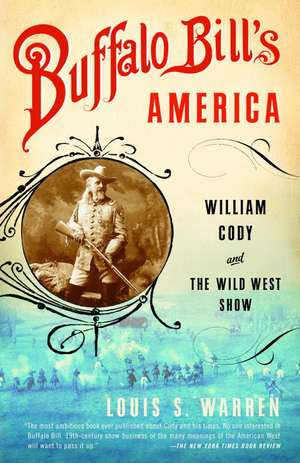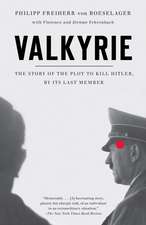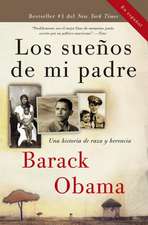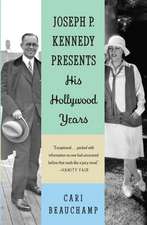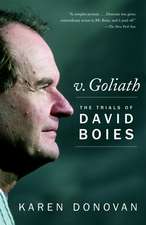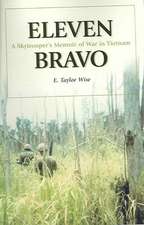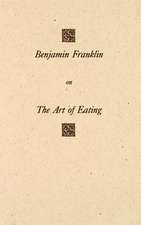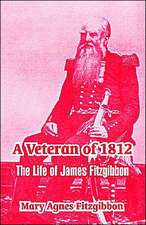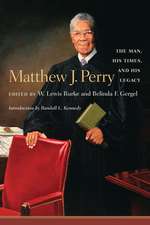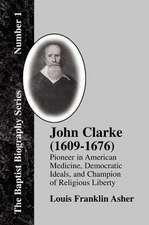Buffalo Bill's America: William Cody and the Wild West Show
Autor Louis S. Warrenen Limba Engleză Paperback – 30 noi 2006
Preț: 149.60 lei
Nou
Puncte Express: 224
Preț estimativ în valută:
28.63€ • 29.78$ • 23.64£
28.63€ • 29.78$ • 23.64£
Carte disponibilă
Livrare economică 24 martie-07 aprilie
Livrare express 08-14 martie pentru 37.26 lei
Preluare comenzi: 021 569.72.76
Specificații
ISBN-13: 9780375726583
ISBN-10: 0375726586
Pagini: 652
Ilustrații: 41 ILLUSTRATIONS IN TEXT
Dimensiuni: 161 x 204 x 36 mm
Greutate: 0.83 kg
Editura: Vintage Books USA
ISBN-10: 0375726586
Pagini: 652
Ilustrații: 41 ILLUSTRATIONS IN TEXT
Dimensiuni: 161 x 204 x 36 mm
Greutate: 0.83 kg
Editura: Vintage Books USA
Notă biografică
Louis S. Warren took his B.A. at Columbia University and his M.A., M.Phil. and Ph.D. at Yale University. He has taught at Yale, University of San Diego, and, since 1999, at the University of California, Davis, where he is currently Associate Professor of History. He is the author of The Hunter's Game: Poachers and Conservationists in Twentieth-Century America (1997), which won the 1997 Western Heritage Award for Outstanding Non-Fiction Book, and several articles. His article on "Cody's Last Stand" in the Western Historical Quarterly won the Oscar O. Winther Award for best article (2003).
Extras
Pony Express
The Former Pony Post rider will show how the Letters and Telegrams of the Republic were distributed across the immense Continent previous to the railways and the telegraph.
Like every other frontier reenactment in the Wild West show, the Pony Express was a chapter in the life of its hero and his country. Before audiences of thousands, the horseman-not Cody himself, but another "Former Pony Post" rider-raced "down to the grand stand at a gallop," wrote one ecstatic viewer, "checked his pony within a length, and almost before it was at standstill the rider was on the ground, the bag on another pony, and the man galloping off at full speed, in less time than it would taken an ordinary man to dismount." It was a showstopper.
Of course Buffalo Bill rode the Pony Express. Everyone who perused the sixty or so printed pages of Wild West show programs could read it for themselves. "William F. Cody was born in Scott County, Iowa. He removed at an early age to Kansas, and was employed as a herder, wagonmaster, and pony express rider."
The more curious might buy a copy of Buffalo Bill's autobiography, also for sale at the Wild West show. There they could read the story in detail. Left fatherless at an early age, eleven, the young Kansas boy ventured out to make money for his bereaved mother, five sisters, and infant brother. Between his eleventh birthday, in 1857, and his fifteenth, in 1861, he freighted wagons over the plains with rough teamsters, befriended Wild Bill Hickok, was captured by enemy Mormons in the government's abortive war against polygamy, survived a starvation winter at Fort Bridger, skirmished with some Indians and befriended others, prospected for gold in Colorado, and trapped beaver on the Plains.
But of all the boyhood adventures William Cody claimed, those on the Pony Express were the most astonishing, and the most famous. On his way back to Kansas after failing to find gold at Pikes Peak, the thirteen-year-old boy ambled into the Pony Express station at Julesberg, Colorado, where he talked his way into his first Pony Express job. His mother feared it would kill him. "She was right about this, as fifteen miles an hour on horseback would, in a short time, shake any man 'all to pieces'; and there were but very few, if any, riders who could stand it for a great length of time." But young Will Cody took up his forty-five-mile route, and "stuck to it for two months," before he returned to Kansas to be with his mother, who had fallen ill.
After she recovered, the boy and a friend tried their hand at trapping beaver up the remote reaches of the Republican River, in western Kansas. They lost an ox, and so were unable to move their wagon when Cody slipped on the ice and broke his leg. Left behind while his friend went for a replacement ox team, the young boy spent a month alone, and avoided being killed by a Sioux war party only because its leader, Chief Rain-in-the-Face, remembered meeting the young Will Cody at Fort Laramie the previous year.
The following summer, in 1860, when he was fourteen, Cody returned to Pony Express riding again, and his adventures made his previous escapades seem pale in comparison. Warned that "it will soon shake the life out of you," he took up the most dangerous length of the Pony Express route, the Sweetwater Division. This section was under the supervision of John Slade, a notorious killer, but Cody recalled the man as civil, even kind, in his autobiography.
"My boy, you are too young for a pony-express rider. It takes men for that business."
"I rode two months last year on Bill Trotter's division, sir, and filled the bill then; and I think I am better able to ride now," said I.
"What! are you the boy that was riding there, and was called the youngest rider on the road?"
"I am the same boy," I replied, confident that everything was now all right for me.
The boy proved himself more than equal to the man-size job. Arriving at the end of his seventy-six-mile stretch of road one day, he discovered that the rider to whom he was to pass the specially designed saddlebag, or mochila, had been killed in a drunken brawl the night before. Cody "did not hesitate for a moment to undertake an extra ride of eighty-five miles to Rocky Ridge," where he arrived on time. "I then turned and rode to Red Buttes, my starting place, accomplishing on the round trip a distance of 322 miles," which would go down in history as one of the longest Pony Express rides ever.
Shortly afterward, he outran an Indian attack, making a twenty-four-mile run on one horse. Not much later, the Indians attacked a company stagecoach between Split Rock and Three Crossings, and managers suspended the pony service. During this lull, the young Cody set out with his friend Wild Bill Hickok and a group of forty men "who had undergone all kinds of hardships and braved every danger" to pursue the Indians and recover stolen horses. They found the Indian encampment up the Powder River, raided it, and returned "with all of our own horses and about one hundred captured Indian ponies."
Ever since 1879, when William Cody first published his life story, this childhood saga has been a favorite of the American public. The Wild West show reprised it over and over again, the high-speed Pony Express scene in Buffalo Bill's Wild West inscribing an almost indelible bond between young America and the child Will Cody. The pony was featured in the show's debut in 1883, and audiences from Omaha to New York, Sarasota to Paris, thrilled to the display every year thereafter until the show ended in 1916.
Cody's boyhood story of horseback days, of a boy who enters a man's world too early, was a familiar one in some respects. Young Will, the story's hero, is the victim of bad circumstances, but raises himself up through hard work, ambition, and good luck, meeting powerful men such as Chief Rain-in-the-Face, Wild Bill Hickok, and John Slade, who patronize his efforts. Like a western version of Horatio Alger's Ragged Dick, which had first appeared twelve years earlier, Cody's life story was an exhortation to the sons of the middle class. It inspired faith in the stage star, Buffalo Bill Cody, as a genuine western figure and a respectable, middle-class icon for the urban middle classes who were its intended audience. It extolled family, hard work, and willingness to take risks-all virtues of the middle-class family in the industrial age. "Mr. Cody tells his story in a simple, unaffected style that commands belief," wrote one reviewer, "and it is about as full of incident and adventure as its pages will allow." The book was respectable, too, not like dime novels which corrupted the nation's youth with romantic tales of theft and bloodshed. The reviewer doubted that "the perusal of the book will lure a single boy to run away from school, steal a revolver and tramp to the border, for somehow the men who know what frontier life really is always give the impression that there is a great deal of downright hard work about the borderer's life."
What if you wanted to know more about those Pony Express adventures? The problem was there was not much to read on the subject other than Buffalo Bill's autobiography and show programs. The freighting firm of Russell, Majors, and Waddell created the Pony Express to carry mail between Saint Joseph, Missouri, and Sacramento, California, in 1860. The service was wildly popular, especially in California, where it was memorialized in heroic tributes even as it began.
But it lasted only eighteen months. When it ended, in 1861, the Civil War had erupted. The epic clash of North and South at Shiloh, Gettysburg, and the Wilderness absorbed the energies of almost every American historian for the next three decades. Few attempted unpacking the West until the 1880s. Nobody wrote a book-length history of the Pony Express until after 1900.
In the meantime, Buffalo Bill's Wild West show became the primary keeper of the pony legend. By the 1890s, when William Lightfoot Visscher began gathering material for his history of the Pony Express, the business records of Russell, Majors, and Waddell had long since vanished, and Buffalo Bill's Wild West show had been promoting William Cody's version of the pony's history for the better part of two decades. Cody was the world's most renowned showman and westerner, and had made himself far and away the most famous rider of the legendary pony line. He was also a personal friend of Visscher's. When the journalist's Thrilling and Truthful History of the Pony Express appeared in 1908, it was less history than hagiography, a devotional recounting of the heroic lives of saints. The author repeated Cody's stories without any criticism.
Since then, every scholarly history of the Pony Express has mentioned Buffalo Bill's adventures. Every generation of Americans has thrilled to them in a succession of children's books and movies which have retold his Pony Express days as wholesome, outdoor, familial inspiration to American youth. To this day, William F. Cody's stature as the most famous Pony Express rider of them all remains largely unchallenged.
Only the most devoted reader knows about the doubters. Some who knew Cody said he was lying even in the 1880s. A few historians mention in footnotes or even in the text of their books that his stories are impossible to verify. A tiny minority have suggested he made the whole thing up.
Against these whispers, Cody biographers advance the standard of the trustworthy guide. The most famous of these, Don Russell, long ago concluded that Buffalo Bill mostly told the truth. Cody's account is full of genuine figures from the Pony Express, and he pinpoints locations of Indian battles with descriptions that are often accurate. How could he have known so much if he was not there? Besides, William Cody won the Medal of Honor for Indian fighting in 1872. He was already a wealthy man and a stage star when he put the story in his autobiography in 1879. He had no reason to lie.
How much of the story was true? The search for answers is illuminating in two ways. On the one hand, it may lead us to matters of fact, about what really happened to the boy William Cody. On the other hand, poring over Cody's stories, true and false, can point the way to deeper truths. A man lies to mislead. But, as any detective can tell you, the most deceptive liar reveals a great deal about himself through his choice of untruths. Lies cover the teller's tracks, but they also betray how he thinks. The line between truth and fiction in William Cody's childhood story is less a boundary marker between the serious and the trivial than a pathway to a deeper understanding of the man and his age.
What we know of Cody's childhood comes largely from two sources: his own autobiography, which he published in 1879, when he was already a theatrical star, and the memoirs of his elder sister, Julia, which she didn't pen till the early 1900s. The veracity of his autobiography is a constant source of debate. Written in Rochester, New York, during his off-season from the theater, it was a long press release meant to enhance his already formidable star qualities. Cody shaped his life story to meet public expectations and desires. Every single one of the book's claims must be treated with care.
The question of its authorship endures. A coterie of press agents and dime novelists churned out revised editions of the Cody autobiography periodically through 1920. During the same period, dozens of ghostwritten dime novels appeared under Buffalo Bill's authorship. Many critics have lumped Cody's 1879 autobiography with the novels, as the hokum of some advance man or another. But if the pages of some later editions are purple with hack writers' clichés, the prose in this first edition of his life story is markedly restrained (as reviewers noted at the time). Moreover, it is full of what we know to be Cody's own phrasing and tone. It contains a great deal of truth that only Cody knew. If he did not write it, he dictated it. For all its many fictions, it stands as Buffalo Bill Cody's own story of his life from childhood to the age of thirty-three.
Julia Cody's memoirs offer some correctives to her brother's fantasies, but she was understandably reluctant to contradict him. In many cases, neither sibling was entirely truthful. Reading these two accounts against one another, and weighing them against the handful of other evidence we can muster, we begin to discern real events of his childhood under the quilting of fiction which covered them.
William Cody, hero of the Indian wars, did outrun murderous enemies as a boy. But they were not Indians. He did carry messages, but not the U.S. mail. He had his first taste of combat as a very young man, but when he first sighted down a rifle barrel at a man, it was likely not at any Sioux or Cheyenne. The West of the boy William Cody was riven by war on families, in which homes burned, and families were threatened, scattered, or worse. War defined his life from the time he was eight until he was about thirty. And in war he learned, above all else, the vulnerability of family and home.
William Frederick Cody was born near Leclaire, Iowa, on February 26, 1846. His father, Isaac Cody, had been born in Canada and at the age of seventeen had settled in Ohio with his parents and siblings. He was already a widower when he met and married Mary Laycock in Cincinnati in 1840. Soon after, the couple, with Isaac's daughter from an earlier marriage, Martha, moved to Iowa in search of new opportunities. William Cody was the third child of Isaac and Mary, having been preceded by a brother, Sam, in 1841, and a sister, Julia, in 1843. By 1853, there were seven children at home, including the two brothers and a total of five sisters: Martha, Julia, Eliza Alice, Laura Ella (often called Helen), and Mary Hannah, called May. In Iowa, Isaac Cody managed large farms for absentee owners, and ran a stage business between Davenport and Chicago. The children recalled their father as a traveling man who returned home between trips ferrying passengers across the wide prairie. Sometimes the young Codys stood on the riverbank, watching as Isaac's brightly colored wagon passed by on its way to or from Chicago. The constant search for new opportunities led Isaac to consider joining the gold rush to California. He changed his mind when he heard tales of woe from returning emigrants and was unable to finance the trip. Instead, he and Mary Cody settled on a move to Kansas Territory. Their decision may have been motivated in part by the death of their eldest son, Sam, crushed beneath a bucking mare in 1853, at the age of twelve.
From the Hardcover edition.
The Former Pony Post rider will show how the Letters and Telegrams of the Republic were distributed across the immense Continent previous to the railways and the telegraph.
Like every other frontier reenactment in the Wild West show, the Pony Express was a chapter in the life of its hero and his country. Before audiences of thousands, the horseman-not Cody himself, but another "Former Pony Post" rider-raced "down to the grand stand at a gallop," wrote one ecstatic viewer, "checked his pony within a length, and almost before it was at standstill the rider was on the ground, the bag on another pony, and the man galloping off at full speed, in less time than it would taken an ordinary man to dismount." It was a showstopper.
Of course Buffalo Bill rode the Pony Express. Everyone who perused the sixty or so printed pages of Wild West show programs could read it for themselves. "William F. Cody was born in Scott County, Iowa. He removed at an early age to Kansas, and was employed as a herder, wagonmaster, and pony express rider."
The more curious might buy a copy of Buffalo Bill's autobiography, also for sale at the Wild West show. There they could read the story in detail. Left fatherless at an early age, eleven, the young Kansas boy ventured out to make money for his bereaved mother, five sisters, and infant brother. Between his eleventh birthday, in 1857, and his fifteenth, in 1861, he freighted wagons over the plains with rough teamsters, befriended Wild Bill Hickok, was captured by enemy Mormons in the government's abortive war against polygamy, survived a starvation winter at Fort Bridger, skirmished with some Indians and befriended others, prospected for gold in Colorado, and trapped beaver on the Plains.
But of all the boyhood adventures William Cody claimed, those on the Pony Express were the most astonishing, and the most famous. On his way back to Kansas after failing to find gold at Pikes Peak, the thirteen-year-old boy ambled into the Pony Express station at Julesberg, Colorado, where he talked his way into his first Pony Express job. His mother feared it would kill him. "She was right about this, as fifteen miles an hour on horseback would, in a short time, shake any man 'all to pieces'; and there were but very few, if any, riders who could stand it for a great length of time." But young Will Cody took up his forty-five-mile route, and "stuck to it for two months," before he returned to Kansas to be with his mother, who had fallen ill.
After she recovered, the boy and a friend tried their hand at trapping beaver up the remote reaches of the Republican River, in western Kansas. They lost an ox, and so were unable to move their wagon when Cody slipped on the ice and broke his leg. Left behind while his friend went for a replacement ox team, the young boy spent a month alone, and avoided being killed by a Sioux war party only because its leader, Chief Rain-in-the-Face, remembered meeting the young Will Cody at Fort Laramie the previous year.
The following summer, in 1860, when he was fourteen, Cody returned to Pony Express riding again, and his adventures made his previous escapades seem pale in comparison. Warned that "it will soon shake the life out of you," he took up the most dangerous length of the Pony Express route, the Sweetwater Division. This section was under the supervision of John Slade, a notorious killer, but Cody recalled the man as civil, even kind, in his autobiography.
"My boy, you are too young for a pony-express rider. It takes men for that business."
"I rode two months last year on Bill Trotter's division, sir, and filled the bill then; and I think I am better able to ride now," said I.
"What! are you the boy that was riding there, and was called the youngest rider on the road?"
"I am the same boy," I replied, confident that everything was now all right for me.
The boy proved himself more than equal to the man-size job. Arriving at the end of his seventy-six-mile stretch of road one day, he discovered that the rider to whom he was to pass the specially designed saddlebag, or mochila, had been killed in a drunken brawl the night before. Cody "did not hesitate for a moment to undertake an extra ride of eighty-five miles to Rocky Ridge," where he arrived on time. "I then turned and rode to Red Buttes, my starting place, accomplishing on the round trip a distance of 322 miles," which would go down in history as one of the longest Pony Express rides ever.
Shortly afterward, he outran an Indian attack, making a twenty-four-mile run on one horse. Not much later, the Indians attacked a company stagecoach between Split Rock and Three Crossings, and managers suspended the pony service. During this lull, the young Cody set out with his friend Wild Bill Hickok and a group of forty men "who had undergone all kinds of hardships and braved every danger" to pursue the Indians and recover stolen horses. They found the Indian encampment up the Powder River, raided it, and returned "with all of our own horses and about one hundred captured Indian ponies."
Ever since 1879, when William Cody first published his life story, this childhood saga has been a favorite of the American public. The Wild West show reprised it over and over again, the high-speed Pony Express scene in Buffalo Bill's Wild West inscribing an almost indelible bond between young America and the child Will Cody. The pony was featured in the show's debut in 1883, and audiences from Omaha to New York, Sarasota to Paris, thrilled to the display every year thereafter until the show ended in 1916.
Cody's boyhood story of horseback days, of a boy who enters a man's world too early, was a familiar one in some respects. Young Will, the story's hero, is the victim of bad circumstances, but raises himself up through hard work, ambition, and good luck, meeting powerful men such as Chief Rain-in-the-Face, Wild Bill Hickok, and John Slade, who patronize his efforts. Like a western version of Horatio Alger's Ragged Dick, which had first appeared twelve years earlier, Cody's life story was an exhortation to the sons of the middle class. It inspired faith in the stage star, Buffalo Bill Cody, as a genuine western figure and a respectable, middle-class icon for the urban middle classes who were its intended audience. It extolled family, hard work, and willingness to take risks-all virtues of the middle-class family in the industrial age. "Mr. Cody tells his story in a simple, unaffected style that commands belief," wrote one reviewer, "and it is about as full of incident and adventure as its pages will allow." The book was respectable, too, not like dime novels which corrupted the nation's youth with romantic tales of theft and bloodshed. The reviewer doubted that "the perusal of the book will lure a single boy to run away from school, steal a revolver and tramp to the border, for somehow the men who know what frontier life really is always give the impression that there is a great deal of downright hard work about the borderer's life."
What if you wanted to know more about those Pony Express adventures? The problem was there was not much to read on the subject other than Buffalo Bill's autobiography and show programs. The freighting firm of Russell, Majors, and Waddell created the Pony Express to carry mail between Saint Joseph, Missouri, and Sacramento, California, in 1860. The service was wildly popular, especially in California, where it was memorialized in heroic tributes even as it began.
But it lasted only eighteen months. When it ended, in 1861, the Civil War had erupted. The epic clash of North and South at Shiloh, Gettysburg, and the Wilderness absorbed the energies of almost every American historian for the next three decades. Few attempted unpacking the West until the 1880s. Nobody wrote a book-length history of the Pony Express until after 1900.
In the meantime, Buffalo Bill's Wild West show became the primary keeper of the pony legend. By the 1890s, when William Lightfoot Visscher began gathering material for his history of the Pony Express, the business records of Russell, Majors, and Waddell had long since vanished, and Buffalo Bill's Wild West show had been promoting William Cody's version of the pony's history for the better part of two decades. Cody was the world's most renowned showman and westerner, and had made himself far and away the most famous rider of the legendary pony line. He was also a personal friend of Visscher's. When the journalist's Thrilling and Truthful History of the Pony Express appeared in 1908, it was less history than hagiography, a devotional recounting of the heroic lives of saints. The author repeated Cody's stories without any criticism.
Since then, every scholarly history of the Pony Express has mentioned Buffalo Bill's adventures. Every generation of Americans has thrilled to them in a succession of children's books and movies which have retold his Pony Express days as wholesome, outdoor, familial inspiration to American youth. To this day, William F. Cody's stature as the most famous Pony Express rider of them all remains largely unchallenged.
Only the most devoted reader knows about the doubters. Some who knew Cody said he was lying even in the 1880s. A few historians mention in footnotes or even in the text of their books that his stories are impossible to verify. A tiny minority have suggested he made the whole thing up.
Against these whispers, Cody biographers advance the standard of the trustworthy guide. The most famous of these, Don Russell, long ago concluded that Buffalo Bill mostly told the truth. Cody's account is full of genuine figures from the Pony Express, and he pinpoints locations of Indian battles with descriptions that are often accurate. How could he have known so much if he was not there? Besides, William Cody won the Medal of Honor for Indian fighting in 1872. He was already a wealthy man and a stage star when he put the story in his autobiography in 1879. He had no reason to lie.
How much of the story was true? The search for answers is illuminating in two ways. On the one hand, it may lead us to matters of fact, about what really happened to the boy William Cody. On the other hand, poring over Cody's stories, true and false, can point the way to deeper truths. A man lies to mislead. But, as any detective can tell you, the most deceptive liar reveals a great deal about himself through his choice of untruths. Lies cover the teller's tracks, but they also betray how he thinks. The line between truth and fiction in William Cody's childhood story is less a boundary marker between the serious and the trivial than a pathway to a deeper understanding of the man and his age.
What we know of Cody's childhood comes largely from two sources: his own autobiography, which he published in 1879, when he was already a theatrical star, and the memoirs of his elder sister, Julia, which she didn't pen till the early 1900s. The veracity of his autobiography is a constant source of debate. Written in Rochester, New York, during his off-season from the theater, it was a long press release meant to enhance his already formidable star qualities. Cody shaped his life story to meet public expectations and desires. Every single one of the book's claims must be treated with care.
The question of its authorship endures. A coterie of press agents and dime novelists churned out revised editions of the Cody autobiography periodically through 1920. During the same period, dozens of ghostwritten dime novels appeared under Buffalo Bill's authorship. Many critics have lumped Cody's 1879 autobiography with the novels, as the hokum of some advance man or another. But if the pages of some later editions are purple with hack writers' clichés, the prose in this first edition of his life story is markedly restrained (as reviewers noted at the time). Moreover, it is full of what we know to be Cody's own phrasing and tone. It contains a great deal of truth that only Cody knew. If he did not write it, he dictated it. For all its many fictions, it stands as Buffalo Bill Cody's own story of his life from childhood to the age of thirty-three.
Julia Cody's memoirs offer some correctives to her brother's fantasies, but she was understandably reluctant to contradict him. In many cases, neither sibling was entirely truthful. Reading these two accounts against one another, and weighing them against the handful of other evidence we can muster, we begin to discern real events of his childhood under the quilting of fiction which covered them.
William Cody, hero of the Indian wars, did outrun murderous enemies as a boy. But they were not Indians. He did carry messages, but not the U.S. mail. He had his first taste of combat as a very young man, but when he first sighted down a rifle barrel at a man, it was likely not at any Sioux or Cheyenne. The West of the boy William Cody was riven by war on families, in which homes burned, and families were threatened, scattered, or worse. War defined his life from the time he was eight until he was about thirty. And in war he learned, above all else, the vulnerability of family and home.
William Frederick Cody was born near Leclaire, Iowa, on February 26, 1846. His father, Isaac Cody, had been born in Canada and at the age of seventeen had settled in Ohio with his parents and siblings. He was already a widower when he met and married Mary Laycock in Cincinnati in 1840. Soon after, the couple, with Isaac's daughter from an earlier marriage, Martha, moved to Iowa in search of new opportunities. William Cody was the third child of Isaac and Mary, having been preceded by a brother, Sam, in 1841, and a sister, Julia, in 1843. By 1853, there were seven children at home, including the two brothers and a total of five sisters: Martha, Julia, Eliza Alice, Laura Ella (often called Helen), and Mary Hannah, called May. In Iowa, Isaac Cody managed large farms for absentee owners, and ran a stage business between Davenport and Chicago. The children recalled their father as a traveling man who returned home between trips ferrying passengers across the wide prairie. Sometimes the young Codys stood on the riverbank, watching as Isaac's brightly colored wagon passed by on its way to or from Chicago. The constant search for new opportunities led Isaac to consider joining the gold rush to California. He changed his mind when he heard tales of woe from returning emigrants and was unable to finance the trip. Instead, he and Mary Cody settled on a move to Kansas Territory. Their decision may have been motivated in part by the death of their eldest son, Sam, crushed beneath a bucking mare in 1853, at the age of twelve.
From the Hardcover edition.
Recenzii
“The most ambitious book ever published about Cody and his times. No one interested in Buffalo Bill, 19th-century show business or the many meanings of the American West will want to pass it up.” —The New York Times Book Review
“Warren writes with the tireless ebullience of a scholar in love with his material. . . . The grocery tabloids missed a good thing by not being around when Buffalo Bill was king of the box office.” —The New York Review of Books
“Meticulously researched and entertaining. . . . A fascinating and accessible study of a man who . . . can still teach us today about how things are not always what they appear to be.” —The Portland Oregonian
“Not just a biography but an examination of the cultures of the eastern United States and Europe and their relationship with the American West.” —The Denver Post
“Warren writes with the tireless ebullience of a scholar in love with his material. . . . The grocery tabloids missed a good thing by not being around when Buffalo Bill was king of the box office.” —The New York Review of Books
“Meticulously researched and entertaining. . . . A fascinating and accessible study of a man who . . . can still teach us today about how things are not always what they appear to be.” —The Portland Oregonian
“Not just a biography but an examination of the cultures of the eastern United States and Europe and their relationship with the American West.” —The Denver Post
Cuprins
Introduction
PART ONE
One: Pony Express
Two: The Attack on the Settler’s Cabin
Three: The Village . . . The Cyclone
Four: With the Prince of Pistoleers
Five: Guide and Scout
Six: Buffalo Hunt
PART TWO
Seven: Theater Star
Eight: Indians, Horses
Nine: Domesticating the Wild West
Ten: The Drama of Civilization: Visual Play and Moral Ambiguity
Eleven: Wild West London
Interlude: Broncho Charlie Miller
Twelve: Wild West Europe
Thirteen: Ghost Dance
Interlude: Standing Bear
Fourteen: Cowboys, Indians, and the Artful Deceptions of Race
Fifteen: Buffalo Bill’s America
Interlude: The Johnson Brothers
PART THREE
Sixteen: Empire of the Home
Seventeen: Showdown in Cheyenne
Interlude: Adele Von Ohl Parker
Eighteen: End of the Trail
Notes
Acknowledgments
Index
From the Hardcover edition.
PART ONE
One: Pony Express
Two: The Attack on the Settler’s Cabin
Three: The Village . . . The Cyclone
Four: With the Prince of Pistoleers
Five: Guide and Scout
Six: Buffalo Hunt
PART TWO
Seven: Theater Star
Eight: Indians, Horses
Nine: Domesticating the Wild West
Ten: The Drama of Civilization: Visual Play and Moral Ambiguity
Eleven: Wild West London
Interlude: Broncho Charlie Miller
Twelve: Wild West Europe
Thirteen: Ghost Dance
Interlude: Standing Bear
Fourteen: Cowboys, Indians, and the Artful Deceptions of Race
Fifteen: Buffalo Bill’s America
Interlude: The Johnson Brothers
PART THREE
Sixteen: Empire of the Home
Seventeen: Showdown in Cheyenne
Interlude: Adele Von Ohl Parker
Eighteen: End of the Trail
Notes
Acknowledgments
Index
From the Hardcover edition.
